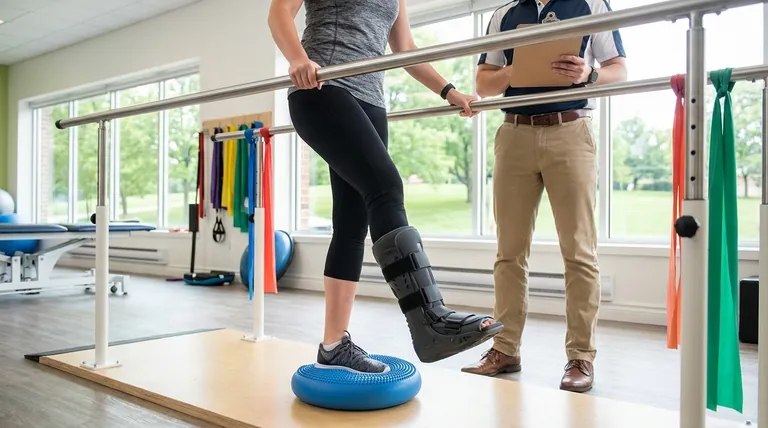The primary focus of exercises during the weight-bearing phase in a boot is to safely restore balance and rebuild muscle strength. This stage is a critical bridge, using controlled and gradually increasing loads to support the final stages of the healing process.
This phase of recovery is about more than just walking; it's a systematic process of retraining your body and mind to trust the injured limb, rebuilding the essential foundations of stability and strength that were lost during immobilization.

The Core Goals of Weight-Bearing Rehabilitation
After a period of being non-weight bearing, your body needs to relearn fundamental skills. The exercises in this phase are designed with specific physiological goals in mind.
Restoring Neuromuscular Control (Balance)
Immobilization weakens the communication pathway between your brain and the muscles in your injured limb.
Balance exercises are crucial for re-establishing this connection, improving your body's ability to sense its position (proprioception) and react to changes in surface or movement.
Rebuilding Atrophied Muscle (Strength)
Muscle loss (atrophy) is an unavoidable consequence of not using a limb.
Targeted strengthening exercises begin the process of rebuilding this lost muscle mass, which is essential for supporting the healing bone and protecting your joints from future injury.
Promoting Healing Through Gradual Load
Bones and soft tissues heal more effectively when they are subjected to controlled, progressive stress.
Applying weight through structured exercise signals the body to deposit more tissue and remodel it in a stronger, more organized way, completing the healing cycle.
Understanding the Key Challenges
Navigating this phase successfully requires an awareness of both the physical and psychological hurdles. A structured approach is key to avoiding setbacks.
The Mental Hurdle of Re-engagement
It is extremely common to feel apprehensive about putting weight on an injury for the first time. This fear is a protective instinct but can hinder progress if not managed.
A gradual increase in weight bearing, often guided by a physical therapist, helps build both physical tolerance and mental confidence.
The Risk of "Too Much, Too Soon"
Eagerness to return to normal activity can lead to pushing too hard, which can cause pain, swelling, and setbacks.
Your body's feedback is the most important guide. Pain is a clear signal to reduce the intensity or duration of an activity.
The Problem of Muscle Imbalances
While your injured limb was healing, the rest of your body—especially the opposite leg, your hips, and your core—was compensating.
These imbalances can lead to other issues down the road if not addressed. A comprehensive program will include exercises to ensure your whole body returns to balanced function.
Making the Right Choice for Your Recovery
This phase is about methodical progress, not speed. Always work under the guidance of a qualified healthcare professional who can tailor a program to your specific injury and needs.
- If your primary focus is safety: Prioritize listening to your body and progressing slowly, never pushing through sharp or increasing pain.
- If your primary focus is regaining full strength: Emphasize the consistent and disciplined execution of your prescribed muscle-building exercises.
- If your primary focus is rebuilding confidence: Start with small, achievable goals to prove to yourself that the limb is ready for more load.
Ultimately, successful navigation of the weight-bearing phase provides the strong foundation you need to return to your life and activities.
Summary Table:
| Focus Area | Primary Goal | Key Benefit |
|---|---|---|
| Balance | Restore Neuromuscular Control | Improves proprioception and stability |
| Strength | Rebuild Atrophied Muscle | Supports healing bone and protects joints |
| Healing | Promote Tissue Remodeling | Gradual load signals the body to strengthen tissue |
Ready to get back on your feet with confidence?
As a leading manufacturer of protective and recovery footwear, 3515 understands the importance of proper support during rehabilitation. Our boots are designed for durability and comfort, providing the stability you need during the critical weight-bearing phase.
If you are a distributor, brand owner, or bulk client looking for high-quality footwear solutions for medical or recovery markets, let's discuss how we can support your product line.
Contact our team today to explore our comprehensive range of footwear and manufacturing capabilities.
Visual Guide

Related Products
- Safety Footwear Wholesale Manufacturer for Custom OEM/ODM Production
- Wholesale Safety Footwear Manufacturer for Bulk & Custom OEM Orders
- Premium High-Cut Waterproof Safety Boots Manufacturing & Wholesale Solutions
- Premium Grain Leather Safety Boots for Bulk Supply
- Premium Wholesale Wheat Nubuck Safety Boot with Rapid Lacing System
People Also Ask
- Is safety-toe as good as steel toe? Choose the Right Protection for Your Job
- What are the differences between steel toe, composite toe, and alloy toe Wellington boots? Choose the Right Safety Toe for Your Job
- How do safety shoes contribute to cost savings for companies? A Strategic Investment in Risk and Cost Management
- Do snake bite boots work? Your Ultimate Guide to Effective Snake Bite Protection
- What cultural and environmental considerations are tied to wearing shoes indoors? Balance Hygiene, Tradition, and Foot Health



















